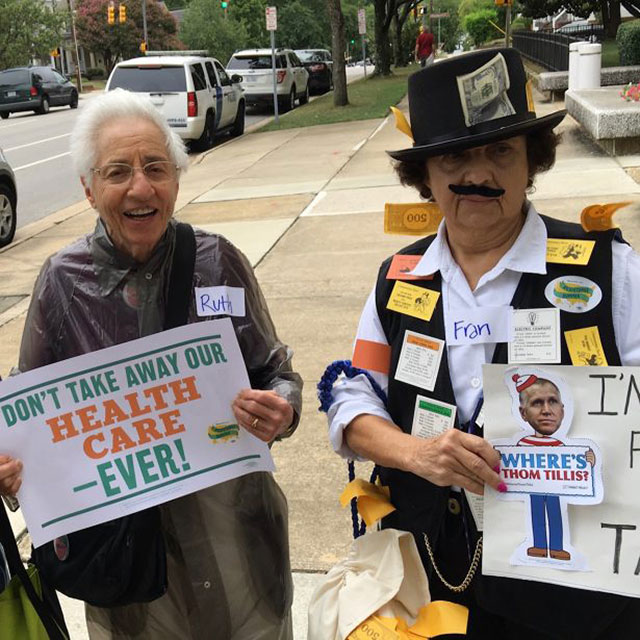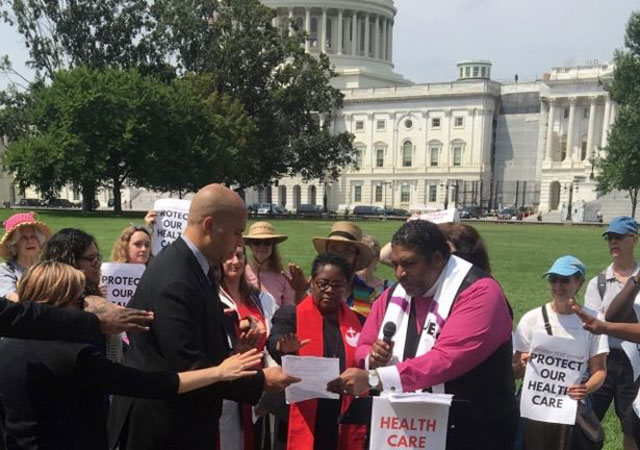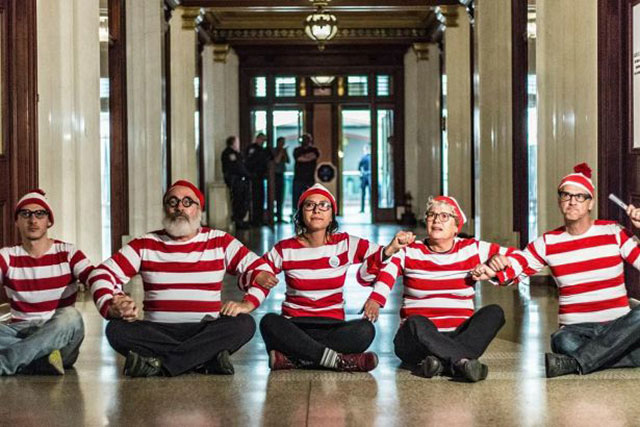
The air in Raleigh, North Carolina was bitterly cold on New Years Eve, but the chill did not stop hundreds of people from gathering for a mass community meeting at the Pullen Baptist Memorial Church. Inside, the band was warming up on stage and friends called out greetings to each other as they went into the main hall.
A group of Raging Grannies filled a pew at the front, wearing floppy hats adorned with activist badges. Locals from North Carolina greeted activists who had traveled from around the country to attend. Some of them had recently been arrested together for protesting the tax bill on Capitol Hill.
As speakers began addressing the audience, people in the crowd linked arms and audience members flocked on stage to sing “We Shall Overcome” and chant “Forward together! Not one step back!” Together, the crowd assembled in Pullen rang in 2018 with a commitment for the coming year: to lead a nationwide campaign to save the “heart and soul” of American democracy.
Officially titled “The Poor People’s Campaign: A National Call for Moral Revival,” the campaign’s objective is to train a massive network of grassroots activists to spark a multi-fronted movement challenging four systemic “evils” in American society: poverty, racism, ecological devastation and the war economy.
One of the key faces of the campaign, former North Carolina NAACP President Rev. William J. Barber, delivered a fiery speech to those gathered in the church on New Years Eve. His voice boomed through the congregation, calling on everyone to “speak truth to power and love to hate in the name of God and all that is holy.”
“What we face is not new,” Barber then told the cheering crowd. “But when you get scared, remember the folks in power are scared too. They’re having nightmares!”
Barber read biblical passages in which the marginalized citizenry — the so-called “stones the builder rejected” — rise up together to face the “wolves” — or politicians — to save their society. In doing so, he added, sometimes they even “save some of the wolves.”
A towering, imposing figure, Barber has been described by activist and professor Cornel West as a modern-day Martin Luther King, Jr. It is easy to draw the parallel, as the Poor People’s Campaign itself is named after an initiative King announced months before his assassination. The campaign is considered an unfinished part of his legacy — a movement seeking to unify people across racial lines around the shared poverty and structural inequalities they experience.
 Demonstrators participating in the Poor People’s March at Lafayette Park and on Connecticut Avenue, Washington, D.C. (Photo: Warren K. Leffler / Wikipedia)
Demonstrators participating in the Poor People’s March at Lafayette Park and on Connecticut Avenue, Washington, D.C. (Photo: Warren K. Leffler / Wikipedia)
The formal launch of the contemporary Poor People’s Campaign was held exactly 50 years after King announced the campaign in 1967 and is gearing up to be the largest nonviolent mobilization in the United States this year. Building on years of organizing within the state of North Carolina, leaders of the Poor People’s Campaign will spend the next five months training, educating and mobilizing communities around the country. Then, on Mother’s Day, the campaign will begin 40 days of widespread civil disobedience, nonviolent direct action and voter education.
The movement aims to draw in labor unions, farm workers, civil rights groups and marginalized communities from around the country, focusing each week on a specific issue of injustice. Each week will include specific policy demands and voter education programs at the state and federal levels, as well as training in nonviolent direct action and civil disobedience. By organizing through local and state chapters, the campaign will maintain a relatively decentralized structure guided by a set of core principles and targets.
Reviving King’s Dream of Challenging Class Divide
One of the major strengths of the Poor People’s Campaign is its potential to appeal to Americans across party lines. It aims to unite the grievances of the marginalized white working class with marginalized communities of immigrants and people of color throughout the country. Barber says this division has kept poor whites and people of color from coming together in common cause for generations. Organizers of the campaign promote a narrative that reaches out to rural or working-class whites — a discourse often employed by politicians on the right, while also emphasizing opposition to sexism, homophobia and racism that are more traditionally territory of the left.
North Carolina activist Tony Quartararo explained his support for the movement in terms of its unifying potential, saying, “[Trump] used xenophobia to play poor whites off against poor black and brown and Muslim people. That’s what the 1 percent has always done, played the 99 percent off against each other and allowed themselves to stay in power.”
Quartararo and his wife Elena Ceberio said they are willing to be involved in supporting the campaign in any way, and have both already been arrested for civil disobedience actions with Barber and others. They say they prefer to stay “in the background” and out of the spotlight, and they enthusiastically promote the movement within their social circle. This year, for example, the couple’s Christmas card featured a photograph of themselves with their son, all clad in black Poor People’s Campaign T-shirts, with a message asking their friends to lend their support. King’s dream was “to bring everybody together,” Quartararo said, and he hopes to draw in people from all walks of life to participate.
References to King are frequent among national and state-level campaign leaders, and much of the movement’s popular legitimacy draws on this connection. The original Poor People’s Campaign, spearheaded by King and the Southern Christian Leadership Conference, sought to bring together people living in poverty across the country in a new March on Washington. The march was intended to pressure Congress and the Johnson administration to pass comprehensive anti-poverty legislation, as well as demand jobs, healthcare and affordable housing. Unlike previous campaigns to fight for the civil rights and voting rights of African Americans, the Poor People’s Campaign addressed issues affecting poor people of all races.
In April 1968, just weeks before the march was scheduled to take place, King was assassinated in Memphis, Tennessee. Rev. Ralph Abernathy was put in charge of organizing the march in his place, along with a group of other civil rights leaders, such as Rev. Jesse Jackson. The march began on Mother’s Day, May 12, 1968, when Coretta Scott King began a two-week-long protest demanding an Economic Bill of Rights. Five thousand protesters descended on the National Mall during the campaign’s first week and built a protest camp called “Resurrection City.” But the encampment was plagued by ceaseless rain, and its inhabitants were ultimately expelled in the middle of the night on June 20. As a result, the campaign has since been considered an unrealized part of King’s dream.
Today, the Poor People’s Campaign aims not only to revive this decades-old dream, but also to reenergize many of the activists who were engaged in the anti-war and civil rights movements in the 1960s and ’70s. David Freeman, who dropped out of high school to join the Poor People’s Campaign in 1968, has played an active role in other Barber-led campaigns. “I know of no organization, past or present, which engenders the same passion and commitment over as broad a coalition as [the Poor People’s Campaign],” Freeman said.
 Fran Schindler (right) with fellow Ranging Granny Ruth Zalph. (Photo: David Freeman / WNV)
Fran Schindler (right) with fellow Ranging Granny Ruth Zalph. (Photo: David Freeman / WNV)
The campaign also represents a second chance for those who played a less active role in social justice struggles of that era. At 78 years old, Fran Schindler laments “missing her chance” to participate in the social movements of the 1960s, having spent those years raising small children. But after attending the Women’s March in Washington, D.C., she felt the time had come to take a stand. “It was an awakening, if you want to call it that,” Schindler said. “It wasn’t my time to do it back then, when I wanted to be doing it so much and felt I was being left out. But now’s my time.”
Having had a double mastectomy, Schindler has gone to protests with slogans like “This is what a preexisting condition looks like” painted across her chest. After the inauguration, she said she was grateful to find a way to “let it out” by “going topless and screaming” at the top of her lungs. “I’ve got some feminist stuff in me,” she laughed. “Just because a woman’s got no breasts does not mean she is any less of a woman.”
Roots in North Carolina’s Progressive Resistance
Supporters like Schindler, Quartararo and Ceberio learned about the Poor People’s Campaign through a series of actions in North Carolina targeting reforms on the state level, which had been organized by Barber and other progressive groups around the state. After the Republicans won a majority in North Carolina’s state legislature in 2010 and the governorship in 2012, Barber launched the Moral Mondays movement in April 2013. He led protests bearing “moral witness” to the state legislature’s far-right agenda, which included attacks on health care, women’s rights, LGBTQ rights and voting rights throughout the state.
The movement gained momentum when 17 people were arrested at the first Moral Monday demonstration in the summer of 2013. Within months, there had been over a thousand arrests, sparking more actions throughout North Carolina. These included the “Tuesdays with Tillis” demonstrations outside Sen. Thom Tillis’ office in Raleigh and the “Air Horn Orchestra” demonstrations every Wednesday outside Gov. Pat McCrory’s mansion, protesting issues like gerrymandering and environmental degradation.
 Rev. Barber and Sen. Cory Booker at a health care protest outside Congress in August. (Photo: David Freeman / WNV)
Rev. Barber and Sen. Cory Booker at a health care protest outside Congress in August. (Photo: David Freeman / WNV)
Barber became a leading figure of progressive resistance in the North Carolina NAACP, the organization’s second largest state chapter, while serving as its president for 11 years. Barber stepped down in May 2017 to join Presbyterian Rev. Liz Theoharis in co-chairing the Poor People’s Campaign. Theoharis runs the New York-based Kairos Center for Religions, Rights, and Social Justice and is the founder of the Poverty Initiative. Although Theoharis often speaks at mass meetings and Poor People’s Campaign events, she is less visible in the public spotlight than Barber, who was more involved in state-level organizing in the years leading up to the campaign launch.
Barber is also known for his role as head of the non-profit organization Repairers of the Breach and for leading the “Forward Together” movement, which began organizing the annual Moral March to the Raleigh statehouse every February, also known as the Historic Thousands on Jones Street, or HKonJ. The march is put on by the HKonJ People’s Assembly Coalition, a group comprised of over 125 North Carolina NAACP branches, youth councils and college chapters, as well as representatives from over 200 other social justice organizations. The march has produced some of the largest civil rights gatherings in the South since Selma and Birmingham, and will take place again this February.
A Fusion of Movements
One of the campaign’s strengths, aside from a strong foundation in grassroots organizing, is its aim to draw together many smaller organizations and campaigns into what Barber calls a “fusion of movements.” Back in 2014, in the early planning stages of the campaign, over a hundred leaders from more than 40 organizations began holding strategic dialogues to plan the Poor People’s Campaign, and it has been seen as broadly encompassing many other movements ever since.
The campaign has so far succeeded in drawing in many smaller groups, like the Pennsylvania-based March on Harrisburg. Community organizer and march leader Kyle Moore was inspired to join the coordinating committee for the Pennsylvania state chapter of the Poor People’s Campaign after he was arrested with Barber in July. Moore was a key organizer of the March on Harrisburg, a group that held a 105-mile march from Philadelphia to the Pennsylvania state legislature in Harrisburg in May 2017. The same group was also arrested in November, when they dressed up as the “Where’s Waldo” character to make the point that it is easier to find Waldo than elected officials. They were also drawing attention to issues of gerrymandering, voter suppression and political corruption at the state level.
 Members of the Pennsylvania-based March on Harrisburg dressed as “Where’s Waldo.” (Photo: David Freeman / WNV)
Members of the Pennsylvania-based March on Harrisburg dressed as “Where’s Waldo.” (Photo: David Freeman / WNV)
“What we did with the March on Harrisburg is very similar to what the Poor People’s Campaign is doing,” Moore said. “If you don’t have voting rights, you’re going to have people in office voting for things that a majority of people don’t support.”
The Pennsylvania Coordinating Committee will be organizing state-wide “barnstorming” efforts with the Pennsylvania chapter from January until March, hosting trainings in Unitarian Universalist churches on citizen lobbying and civil disobedience. Moore, who is also a trained civil rights historian, said he became passionate about the campaign after watching Barber speak to thousands of people at a church in New York City. “He’s so much like Martin Luther King, Jr.,” Moore said. “My feet started dancing a little bit. The way he talks is like a rhythm, it’s like a prophet. You’re willing to follow him down any road that could restore democracy in this country.”
While the campaign is garnering substantial enthusiasm in local and state chapters, as well as painting a compelling narrative of unity among marginalized and disenfranchised groups in America, many hurdles remain. Organizers will be pressed to forge a movement among diverse interest groups, develop a clear strategy with attainable goals, and maintain the enthusiasm of early supporters while also drawing in new participants. What’s more, they face the same problem as the original Poor People’s Campaign: having a single charismatic leader as the face of the movement. If such figures become unable to lead, as we have seen, the campaign can lose momentum and direction.
Nevertheless, the Poor People’s Campaign has already laid the groundwork for major mobilizations in 2018, drawing in numerous stakeholders and whipping up a frenzy of enthusiasm from supporters across the country. “Yes, we need to keep checking ourselves critically, to improve outreach to youth,” Freeman said. “But all progressive organizations are struggling with these issues. The Poor People’s Campaign is the most hopeful, most powerful coalition we have going. Nothing compares to it in breadth.”
For now, Barber’s leadership remains a strong asset for inspiring dedicated participants and drawing the campaign into the national spotlight. As Schindler boldly declared, “I am definitely throwing what’s left of me in with his mission. Wherever he goes, I will follow him.”
We’re not backing down in the face of Trump’s threats.
As Donald Trump is inaugurated a second time, independent media organizations are faced with urgent mandates: Tell the truth more loudly than ever before. Do that work even as our standard modes of distribution (such as social media platforms) are being manipulated and curtailed by forces of fascist repression and ruthless capitalism. Do that work even as journalism and journalists face targeted attacks, including from the government itself. And do that work in community, never forgetting that we’re not shouting into a faceless void – we’re reaching out to real people amid a life-threatening political climate.
Our task is formidable, and it requires us to ground ourselves in our principles, remind ourselves of our utility, dig in and commit.
As a dizzying number of corporate news organizations – either through need or greed – rush to implement new ways to further monetize their content, and others acquiesce to Trump’s wishes, now is a time for movement media-makers to double down on community-first models.
At Truthout, we are reaffirming our commitments on this front: We won’t run ads or have a paywall because we believe that everyone should have access to information, and that access should exist without barriers and free of distractions from craven corporate interests. We recognize the implications for democracy when information-seekers click a link only to find the article trapped behind a paywall or buried on a page with dozens of invasive ads. The laws of capitalism dictate an unending increase in monetization, and much of the media simply follows those laws. Truthout and many of our peers are dedicating ourselves to following other paths – a commitment which feels vital in a moment when corporations are evermore overtly embedded in government.
Over 80 percent of Truthout‘s funding comes from small individual donations from our community of readers, and the remaining 20 percent comes from a handful of social justice-oriented foundations. Over a third of our total budget is supported by recurring monthly donors, many of whom give because they want to help us keep Truthout barrier-free for everyone.
You can help by giving today. Whether you can make a small monthly donation or a larger gift, Truthout only works with your support.